Adelaide city centre
Coordinates: 34°55′44″S 138°36′04″E / 34.929°S 138.601°E
| Adelaide Adelaide, South Australia | |||||||||||||
|---|---|---|---|---|---|---|---|---|---|---|---|---|---|
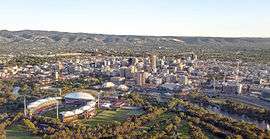 Aerial view of the Adelaide city centre from the northwest | |||||||||||||
| Population | |||||||||||||
| • Density | 1,234/km2 (3,197/sq mi) | ||||||||||||
| Established | 1837 | ||||||||||||
| Postcode(s) | 5000 | ||||||||||||
| Area | 10.5 km2 (4.1 sq mi) | ||||||||||||
| Location |
| ||||||||||||
| State electorate(s) | Adelaide | ||||||||||||
| Federal Division(s) | Adelaide | ||||||||||||
| |||||||||||||
Adelaide city centre is the innermost locality of Greater Adelaide, the capital city of South Australia. It is known by locals simply as "The City" or "Town" to distinguish it from Greater Adelaide and from the City of Adelaide (which also includes North Adelaide and the parklands). The locality is split into two key geographical distinctions: the city "square mile", bordered by North, East, South and West Terraces; and the section of the Adelaide Parklands south of the River Torrens which separates the built up part of the city from the surrounding suburbs and North Adelaide.
The locality is home to the Parliament of South Australia and many key state government offices. Due to the construction of many new apartments in the city, the population grew from 10,229 (2006 census)[2] to 12,962 (2011 census).[1]
History

Before the European settlement of South Australia, the Adelaide Plains, on which Adelaide was built, were home to the Kaurna group of Indigenous Australians. The colony of South Australia was established in 1836 at Glenelg, and the city itself established in 1837. The location and layout of the city is accredited to Colonel William Light (1786–1839), in a plan known as Light's Vision. The area where the Adelaide city centre now exists was once known as "Tarndanya",[3] which translates as "male red kangaroo rock" in Aboriginal, an area along the south bank of what is now known as the River Torrens, which flows through Adelaide.
Kaurna numbers were significantly reduced by at least two widespread epidemics of smallpox which preceded European settlement, having been transported downstream along the Murray River. When European settlers arrived in 1836, estimates of the Kaurna population ranged from 300 to 1000 people. British Captain Matthew Flinders, along with French Captain Nicolas Baudin, charted the southeast coast of Australia, where Adelaide is located. Flinders named Mount Lofty in 1802, but provided little information on Adelaide itself.
Charles Sturt later explored the Murray and wrote a favourable reflection on what he saw. Colonel William Light is credited largely with settling and laying out the Adelaide region, which included a grid plan of Adelaide's streets. Adelaide was not as badly effected by the 1860s economic depression of Australia as other gold rush cities like Sydney and Melbourne, allowing it to prosper. Historian F.W. Crowley noted that the city was full of elite upper class citizens which provided a stark contrast of the grinding poverty of the labour areas and slums outside the inner city ring. Due to its historic puritan wealth during the 20th century, the city retains a notable portion of Victorian architecture.
Geography
Built environment

Adelaide is separated from its greater metropolitan area by a ring of public parklands on all sides. The square mile within the parklands is defined by a small area of high rise office and apartment buildings in the centre north, around King William Street, which runs north-to-south through the centre. Surrounding this central business district are a large number of medium to low density apartments, townhouses and detached houses which make up the residential portion of the city centre.
Layout
The layout of Adelaide, known as Light's Vision, features a cardinal direction grid pattern of wide streets and terraces and five large public squares: Victoria Square in the centre of the city, and Hindmarsh, Light, Hurtle and Whitmore Squares in the centres of each of the four quadrants of the Adelaide city centre. These squares occupy 32 of the 700 numbered "town acre" allotments on Light's plan.
All east-west roads change their names as they cross King William Street, except for North and South terraces.[4] They also alternate between being wide and narrow, 99 and 66 feet (30 and 20 m), except for the central Grote and Wakefield which are extra-wide, 132 feet (40 m),[5] along with the surrounding four terraces.[6] In the south half of the city, in several places the Adelaide City Council has constructed wide footpaths and road markings to restrict traffic to a lesser number of lanes than the full width of the road could support.
The street pairs, design widths, and town acres in Light's Vision are illustrated in this diagram:
| |
|||||||||||||||||||||||||||||||||||||||||||||||
| W e s t T e r r a c e |
North Terrace | E a s t T c e |
132 ft | ||||||||||||||||||||||||||||||||||||||||||||
| 1 | 2 | 3 | 4 | 5 | 6 | 7 | 8 | M o r |
9 | 10 | 11 | 12 | 13 | 14 | 15 | 16 | K i n g |
17 | 18 | 19 | 20 | 21 | 22 | 23 | 24 | P u l |
25 | 26 | 27 | 28 | 29 | 30 | 31 | ||||||||||||||
| 62 | 61 | 60 | 59 | 58 | 57 | 56 | 55 | 54 | 53 | 52 | 51 | 50 | 49 | 48 | 47 | 46 | 45 | 44 | 43 | 42 | 41 | 40 | 39 | 38 | 37 | 36 | 35 | 34 | 33 | 32 | |||||||||||||||||
| Hindley | Street | Rundle | Street | 66 ft | |||||||||||||||||||||||||||||||||||||||||||
| 63 | 64 | 65 | 66 | 67 | 68 | 69 | 70 | 71 | 72 | 73 | 74 | 75 | 76 | 77 | 78 | 79 | 80 | 81 | 82 | 83 | 84 | 85 | 86 | 87 | 88 | 89 | 90 | 91 | 92 | 93 | |||||||||||||||||
| 124 | 123 | 122 | 121 | 120 | 119 | 118 | Light Square |
115 | 114 | 113 | 112 | 111 | 110 | 109 | 108 | 107 | 106 | 105 | 104 | 103 | 102 | Hind- marsh Square |
99 | 98 | 97 | 96 | 95 | 94 | |||||||||||||||||||
| Currie | Street | Grenfell | Street | 99 ft | |||||||||||||||||||||||||||||||||||||||||||
| 125 | 126 | 127 | 128 | 129 | 130 | 131 | 134 | 135 | 136 | 137 | 138 | 139 | 140 | 141 | 142 | 143 | 144 | 145 | 146 | 147 | 150 | 151 | 152 | 153 | 154 | 155 | |||||||||||||||||||||
| 186 | 185 | 184 | 183 | 182 | 181 | 180 | 177 | 176 | 175 | 174 | 173 | 172 | 171 | 170 | 169 | 168 | 167 | 166 | 165 | 164 | 161 | 160 | 159 | 158 | 157 | 156 | |||||||||||||||||||||
| Waymouth | p h e t t |
Street | Pirie | t e n e y |
Street | 66 ft | |||||||||||||||||||||||||||||||||||||||||
| 187 | 188 | 189 | 190 | 191 | 192 | 193 | 194 | 195 | 196 | 197 | 198 | 199 | 200 | 201 | 202 | 203 | 204 | 205 | 206 | 207 | 208 | 209 | 210 | 211 | 212 | 213 | 214 | 215 | 216 | 217 | 218 | H u t t S t r e e t |
219 | ||||||||||||||
| 252 | 251 | 250 | 249 | 248 | 247 | 246 | 245 | 244 | 243 | 242 | 241 | 240 | 239 | 238 | 237 | 236 | 235 | 234 | 233 | 232 | 231 | 230 | 229 | 228 | 227 | 226 | 225 | 224 | 223 | 222 | 221 | 220 | |||||||||||||||
| Franklin | Street | Flinders | Street | 99 ft | |||||||||||||||||||||||||||||||||||||||||||
| 253 | 254 | 255 | 256 | 257 | 258 | 259 | 260 | 261 | 262 | 263 | 264 | 265 | 266 | 267 | Victoria Square |
270 | 271 | 272 | 273 | 274 | 275 | 276 | 277 | 278 | 279 | 280 | 281 | 282 | 283 | 284 | 285 | 286 | |||||||||||||||
| 320 | 319 | 318 | 317 | 316 | 315 | 314 | 313 | 312 | 311 | 310 | 309 | 308 | 307 | 306 | 303 | 302 | 301 | 300 | 299 | 298 | 297 | 296 | 295 | 294 | 293 | 292 | 291 | 290 | 289 | 288 | 287 | ||||||||||||||||
| Grote Street | Wakefield Street | 132 ft | |||||||||||||||||||||||||||||||||||||||||||||
| 321 | 322 | 323 | 324 | 325 | 326 | 327 | 328 | B r o w n |
329 | 330 | 331 | 332 | 333 | 334 | 335 | 338 | 339 | 340 | 341 | 342 | 343 | 344 | H a n s o n |
345 | 346 | 347 | 348 | 349 | 350 | 351 | 352 | 353 | 354 | 355 | 356 | ||||||||||||
| 392 | 391 | 390 | 389 | 388 | 387 | 386 | 385 | 384 | 383 | 382 | 381 | 380 | 379 | 378 | 375 | 374 | 373 | 372 | 371 | 370 | 369 | 368 | 367 | 366 | 365 | 364 | 363 | 362 | 361 | 360 | 359 | 358 | 357 | ||||||||||||||
| Gouger | Street | W i l l i a m S t |
Angas | Street | E a s t |
99 ft | |||||||||||||||||||||||||||||||||||||||||
| 393 | 394 | 395 | 396 | 397 | 398 | 399 | 400 | 401 | 402 | 403 | 404 | 405 | 406 | 407 | 408 | 409 | 410 | 411 | 412 | 413 | 414 | 415 | 416 | 417 | 418 | 419 | 420 | 421 | 422 | 423 | 424 | 425 | 426 | 427 | 428 | 429 | 430 | ||||||||||
| 468 | 467 | 466 | 465 | 464 | 463 | 462 | 461 | 460 | 459 | 458 | 457 | 456 | 455 | 454 | 453 | 452 | 451 | 450 | 449 | 448 | 447 | 446 | 445 | 444 | 443 | 442 | 441 | 440 | 439 | 438 | 437 | 436 | 435 | 434 | 433 | 432 | 431 | ||||||||||
| Wright | Street | Carrington | Street | 66 ft | |||||||||||||||||||||||||||||||||||||||||||
| 469 | 470 | 471 | 472 | 473 | 474 | 475 | Whit- more Square |
478 | 479 | 480 | 481 | 482 | 483 | 484 | 485 | 486 | 487 | 488 | 489 | 490 | 491 | Hurtle Square |
494 | 495 | 496 | 497 | 498 | 499 | 500 | 501 | 502 | 503 | 504 | 505 | 506 | ||||||||||||
| 544 | 543 | 542 | 541 | 540 | 539 | 538 | 535 | 534 | 533 | 532 | 531 | 530 | 529 | 528 | 527 | 526 | 525 | 524 | 523 | 522 | 519 | 518 | 517 | 516 | 515 | 514 | 513 | 512 | 511 | 510 | 509 | 508 | 507 | ||||||||||||||
| Sturt | Street | Halifax | Street | T c e |
99 ft | ||||||||||||||||||||||||||||||||||||||||||
| 545 | 546 | 547 | 548 | 549 | 550 | 551 | 554 | 555 | 556 | 557 | 558 | 559 | 560 | 561 | 562 | 563 | 564 | 565 | 566 | 567 | 570 | 571 | 572 | 573 | 574 | 575 | 576 | 577 | 578 | 579 | 580 | 581 | 582 | 583 | |||||||||||||
| 622 | 621 | 620 | 619 | 618 | 617 | 616 | 615 | S t |
614 | 613 | 612 | 611 | 610 | 609 | 608 | 607 | 606 | 605 | 604 | 603 | 602 | 601 | 600 | 599 | S t |
598 | 597 | 596 | 595 | 594 | 593 | 592 | 591 | 590 | 589 | 588 | 587 | 586 | 585 | 584 | |||||||
| Gilbert | Street | Gilles | Street | 66 ft | |||||||||||||||||||||||||||||||||||||||||||
| 623 | 624 | 625 | 626 | 627 | 628 | 629 | 630 | 631 | 632 | 633 | 634 | 635 | 636 | 637 | 638 | 639 | 640 | 641 | 642 | 643 | 644 | 645 | 646 | 647 | 648 | 649 | 650 | 651 | 652 | 653 | 654 | 655 | 656 | 657 | 658 | 659 | 660 | 661 | |||||||||
| 700 | 699 | 698 | 697 | 696 | 695 | 694 | 693 | 692 | 691 | 690 | 689 | 688 | 687 | 686 | 685 | 684 | 683 | 682 | 681 | 680 | 679 | 678 | 677 | 676 | 675 | 674 | 673 | 672 | 671 | 670 | 669 | 668 | 667 | 666 | 665 | 664 | 663 | 662 | |||||||||
| South Terrace | 132 ft | ||||||||||||||||||||||||||||||||||||||||||||||
| | |||||||||||||||||||||||||||||||||||||||||||||||
| 132 ft | 99 ft | 132 ft | 99 ft | 132 ft | 132 ft | (width) | |||||||||||||||||||||||||||||||||||||||||
Street names

The streets and squares were named by a committee of a number of prominent settlers after themselves, after early directors of the South Australian Company, after Commissioners appointed by the British government to oversee implementation of the acts that established the colony, and after various notables involved in the establishment of the colony.
The Street Naming Committee comprised:[7]
|
|
All members of the committee (except Stephens) had one or more of the streets and squares in the Adelaide city centre and North Adelaide named after themselves. Brown Street, named for John Brown, was subsequently subsumed as a continuation of Morphett Street in 1967. In the same year, Hanson Street, named for Richard Hanson, was subsumed as a continuation of Pulteney Street.
The squares were named after:
- Victoria - the regent, later the monarch Queen Victoria
- Hindmarsh - Rear Admiral Sir John Hindmarsh, first Governor
- Hurtle - Sir James Hurtle Fisher, first Resident Commissioner
- Light - Colonel William Light, Surveyor General
- Whitmore - William Wolryche-Whitmore MP, a Colonial Commissioner in London
The east-west streets named on 22 December 1836 were:[10]
- Rundle – John Rundle MP, Director of the South Australian Company
- Hindley – Charles Hindley MP, Director of South Australian Company
- Grenfell – Pascoe St Leger Grenfell MP, presented town acre for Holy Trinity Church and other country lands
- Currie – Raikes Currie MP, Director of South Australian Company
- Pirie – Sir John Pirie, alderman and later Lord Mayor of London, Director of South Australian Company
- Waymouth – Henry Waymouth, Director South Australian Company
- Flinders – Matthew Flinders, explorer
- Franklin – Rear Admiral Sir John Franklin, midshipman under Flinders
- Wakefield – Daniel Bell Wakefield, barrister who drafted the South Australia Act[11]
- Grote – George Grote MP, treasurer of the South Australia Association
- Angas – George Fife Angas, a Colonial Commissioner and founding Chairman of Directors of the South Australian Company
- Gouger – Robert Gouger, first Colonial Secretary
Most of these people did not reside in or visit South Australia.
The naming of the streets was completed on 23 May 1837[7] and gazetted on 3 June.[12]
East-west streets:
- Carrington - John Abel Smith (Lord Carrington)
- Wright - John Wright, Colonial Commissioner and financier[13]
- Halifax - Charles Wood, 1st Viscount Halifax, Chancellor of the Exchequer
- Sturt - Charles Sturt, explorer
- Gilles - Osmond Gilles, early treasurer of the colony
- Gilbert - Thomas Gilbert, storekeeper and postmaster[13]
North-south streets:
- Morphett - John Morphett, member of the South Australian parliament
- Pulteney - Admiral Sir Pulteney Malcolm, British naval officer
- Hutt - William Hutt MP, a Colonial Commissioner
Politics
At federal level, Adelaide is within the Division of Adelaide, a marginal seat which historically has alternated between the Liberal and Labor parties. It has been held since 2004 by Kate Ellis of the Labor party.[14]
In the South Australian House of Assembly, Adelaide is within the Electoral district of Adelaide. Since the March 2010 state election, the seat has been held by Rachel Sanderson of the Liberal party.
Culture
Main article: Culture of Adelaide
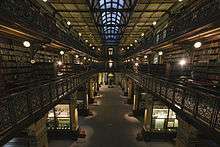
Adelaide's cultural and entertainment precincts/venues are generally concentrated in the city centre. They include the Convention Centre, Entertainment Centre and the redeveloped Adelaide Oval. Additionally, the Adelaide Festival and Adelaide Fringe Festival are held within Adelaide's city centre during February and March. This time is known as "Mad March", due to the large number of other cultural festivities at the same time, including the Adelaide 500 and WOMADelaide. North Terrace is considered Adelaide's "cultural boulevard" because of its tight concentration of galleries and museums.
Gallery
-

Aerial view of the Adelaide city centre looking south-east, 2005.
-
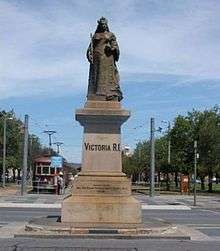
A statue of Queen Victoria has stood in the geometric centre of both Victoria Square and "the square mile" since 1894.
-

Part of North Terrace, 2009.
-

Adelaide CBD from above, 2010.
-

High rise buildings on Hindmarsh Square, 2012.
-

Statue of King Edward VII on North Terrace.
-
St Francis Xavier's Cathedral, Victoria Square.

Pictures of Adelaide city centre skyline
- From the North
-

East Tce to King Wm St, 2012
-

King Wm St to Morphett St, 2012
-

from Light's Vision, 1997
-
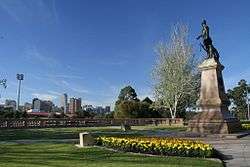
Light's Vision, 2006
-

from Light's Vision, 2008
-

from Light's Vision, 2008
-
from Light's Vision, 2008
-

from Lightsview, 2008
-

"from the North", 2014
- From the East
-

from Mount Lofty, 2005
-
from Waterfall Gully, 2005
-

from Mount Lofty, 2007
-

from Mount Lofty, 2007
-

from Mount Lofty, 2007
-

from Mount Lofty, 2014
- From the South (West -> East)
-

from Flinders University, 2006
-

from circa Panorama, Christmas 2005
-

from Sleeps Hill, 2008
-

from Carrick Hill, 2008
-
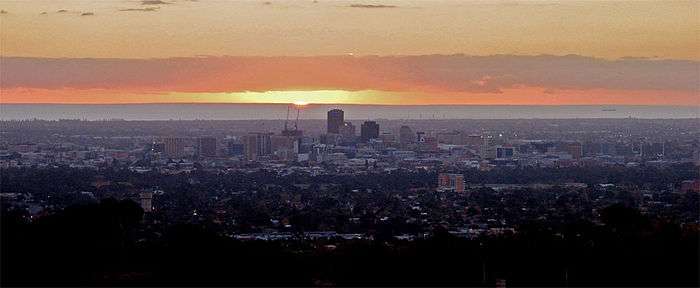
from circa Glen Osmond, 2006
-

from Eagle on the Hill, 1910
- From the West
-

from Hindmarsh Stadium, 2007
-

from Adelaide Airport, 2014
See also
- Adelaide (Greater Adelaide metropolis)
- City of Adelaide (local government area)
Notes
- 1 2 Australian Bureau of Statistics (31 October 2012). "Adelaide (State Suburb)". 2011 Census QuickStats. Retrieved 25 Jan 2015.
- 1 2 Australian Bureau of Statistics (25 October 2007). "Adelaide (State Suburb)". 2006 Census QuickStats. Retrieved 25 October 2007.
- ↑ "Tarndanya", KauranaPlaceNames.com. Retrieved 2009-09-09.
- ↑ Royal Automobile Association. "Adelaide CBD & North Adelaide" (PDF). Retrieved 7 December 2014. This map, showing the Adelaide city centre, North Adelaide and the Adelaide Parklands, was published on the website "soul underground".
- ↑ Elgar, Frederic (1863). Handbook to the Colony of South Australia. London: "Australian and New Zealand Gazette" Office. p. 3. Retrieved 8 December 2014.
... principal north and south streets (from 99 to 132 feet wide) being nearly one mile in length, and the east and west streets (from 66 to 132 feet wide) from a mile and a quarter to a mile and three quarters.
- ↑ Colonel William Light’s Plan of Adelaide, 1837 (Map). Cartography by Robert Thomas for William Light. History SA. 1837. HT2001.166. Retrieved 9 December 2014.
- 1 2 "The Street Naming Committee". HistorySouthAustralia.net. 30 September 2001. Retrieved 22 September 2011.
- ↑ The Colonial Storekeeper, like the Colonial Secretary, was an official position.
- ↑ "Stephens, Edward (1811-1861)". Australian Dictionary of Biography. Canberra: Australian National University. 1967. Retrieved 22 September 2011.
- ↑ "City Streets named 22 December 1836". SAHistorians.org.au.
- ↑ Daniel Bell Wakefield should not to be confused with his uncle, Daniel Wakefield. Note that the street is named after him, not after his better known brother Edward Gibbon Wakefield - Refer Wakefield Street in "Streets Named on the 23rd May, 1837", HistorySouthAustralia.net.
- ↑ "City of Adelaide municipal year book". Adelaide: Adelaide City Council. 1972: 57, 70.
- 1 2 Spence & Beams (2006) p.33
- ↑ Antony Green (27 December 2007). "Adelaide (Inner City) - Green Guide". ABC News Online - Elections. Australian Broadcasting Corporation. Retrieved 3 January 2009.
References
- Spence, Catherine Helen; Beams, Maryan (2006). Susan Magarey, Barbara Wall, Maryan Beams, Mary Lyons, eds. Ever yours, C.H. Spence: Catherine Helen Spence's An autobiography (1825-1910), Diary (1894) and Some correspondence (1894-1910). Wakefield Press. ISBN 978-1-86254-656-1.